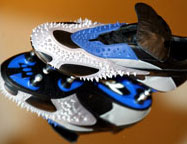Football - Soccer - Futbol
Monday, March 13, 2006

Getting kicked in the shins hurts. Now imagine getting kicked with shoes with studs and with enough force to make a soccer ball travel at 70 mph. Trust me, it really hurts.
(Luckily there are only a few players in the world that can kick a ball that hard and maintain full control: Roberto Carlos from Brasil being one of them.)
Soccer shoes play an important role in the world's soccer market, to the point of paying professional players multi-million dollar shoe endorsement deals. With so much money being spent in designing and pimping these shoes around, does it really make a difference what type of shoe is used while playing the beautiful game?
Apparently someone did an ANOVA study to find out (ANOVA is a fancy acronym statisticians use to describe the process of studing different data sets and compare the difference between them):
When compared with the extensive research for running footwear, the biomechanical properties of soccer cleats have received little scientific attention. Only recently, players, organizations and shoe manufacturers became more interested in modern concepts of athletic footwear design for soccer cleats.
Prevention of injuries and performance enhancement are the key factors for any athletic footwear design. Shooting performance with five different soccer cleat constructions was evaluated, using methods for the measurement of ball speed, shoe deformation and tibial shock. The results of the study demonstrated the benefit of biomechanical analyses for the improvement of athletic footwear.
For ball speeds, the subjects showed low intra-individual coefficients of variation of less than 2% during the repetitive trials for a given shoe. This high repeatability in shooting performance of the individual players is a good basis for detecting statistical between shoe differences. Using an ANOVA (ANalysis Of VAriance between groups), significant between shoe differences were found for maximum ball speed, peak outsole deformation , peak outsole deformation velocity, and shock to the body.
Considering the concept of energy return, one might expect higher ball velocities with an increase of shoe deformation and/or shoe deformation velocity. However, one shoe model showed an opposite behavior. A regression analysis revealed low determination coefficients between ball speed and outsole deformation (rē=0.11) as well as outsole deformation velocity (rē=0.04). Similarly, low determination coefficients were also found for peak tibial acceleration against ball velocity (rē=0.04) as well as outsole deformation (rē=0.04).
[Note: these rē values are so low, that one can almost conclude that there is no statistically significan evidence of any difference in the type of shoe used. However, in some cases rē can be argued either way.]
The study demonstrated that ball velocity and shock transmission to the body is influenced by shoe construction features. For a variety of different cleat constructions, no trend could be found, relating the deformation of the soccer cleat to ball speeds. For a better understanding of the underlying mechanisms, a future study should investigate identical shoes, only differing in the stiffness of their outsoles.
Apparently, it makes a bit of difference in how you kick the ball depending on the type of shoes you wear.
What type of shoe do I wear? For me it's all about support and anti-pronation technology--after a nasty ankle injury my sport's Dr. told me I needed to switch shoes and get custom orthodics. I switched the shoes, but I stopped at the orthodics and I now wear ankle braces on both my feet. Wearing braces makes you loose a bit of ball control, however those ankles are locked--it's a good compromise, as getting sidelined for weeks at a time with a painful ankle injury really, really sucks.
BTW, I still think Brasil is going to win the World Cup. Go Brasil...
BTW2,
Craig Johnston invented those weird looking Adidas Predators. What was he thinking? And now he has a brand new design that makes the shoes look like gladiator boots. The new shoe is called "The Pig":

Comments: